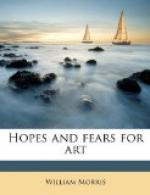But some people may say: And was that to be wished for? would not this universal spreading of art stop progress in other matters, hinder the work of the world? Would it not make us unmanly? or if not that, would it not be intrusive, and push out other things necessary also for men to study?
Well, I have claimed a necessary place for art, a natural place, and it would be in the very essence of it, that it would apply its own rules of order and fitness to the general ways of life: it seems to me, therefore, that people who are over-anxious of the outward expression of beauty becoming too great a force among the other forces of life, would, if they had had the making of the external world, have been afraid of making an ear of wheat beautiful, lest it should not have been good to eat.
But indeed there seems no chance of art becoming universal, unless on the terms that it shall have little self-consciousness, and for the most part be done with little effort; so that the rough work of the world would be as little hindered by it, as the work of external nature is by the beauty of all her forms and moods: this was the case in the times that I have been speaking of: of art which was made by conscious effort, the result of the individual striving towards perfect expression of their thoughts by men very specially gifted, there was perhaps no more than there is now, except in very wonderful and short periods; though I believe that even for such men the struggle to produce beauty was not so bitter as it now is. But if there were not more great thinkers than there are now, there was a countless multitude of happy workers whose work did express, and could not choose but express, some original thought, and was consequently both interesting and beautiful: now there is certainly no chance of the more individual art becoming common, and either wearying us by its over-abundance, or by noisy self-assertion preventing highly cultivated men taking their due part in the other work of the world; it is too difficult to do: it will be always but the blossom of all the half-conscious work below it, the fulfilment of the shortcomings of less complete minds: but it will waste much of its power, and have much less influence on men’s minds, unless it be surrounded by abundance of that commoner work, in which all men once shared, and which, I say, will, when art has really awakened, be done so easily and constantly, that it will stand in no man’s way to hinder him from doing what he will, good or evil. And as, on the one hand, I believe that art made by the people and for the people as a joy both to the maker and the user would further progress in other matters rather than hinder it, so also I firmly believe that that higher art produced only by great brains and miraculously gifted hands cannot exist without it: I believe that the present state of things in which it does exist, while popular art is, let us say, asleep or sick, is a transitional state, which must end at last either in utter defeat or utter victory for the arts.




